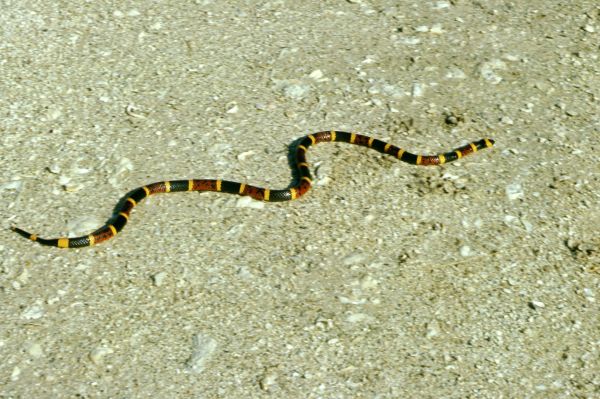Wildlife North America . com North American Animals - mamals, birds, reptiles, insects |
Eastern Coral Snake (Micrurus fulvius)
Eastern Coral Snake Photograph by Luther C. Goldman, U.S. Fish and Wildlife Service. License: Public Domain. (view image details)
EASTERN CORAL SNAKE FACTS
DescriptionThe Eastern Coral Snake has wide red and black rings separated by narrow yellow rings. The rings completely encircle the body. The red rings are usually speckled with black. (The pattern is similar to some of the non-venomous Kingsnake - Coral Snakes have red and yellow bands next to each other, but Kingsnakes have a black band separating the red and yellow. ) The head is black from the snout to just behind the eyes. Other Names American Cobra, Common Coral Snake, Coral Adder, Florida Coral Snake Size usually less than 80cm. Can grow to 120cm Environment coniferous forest, deciduous forest, grassland, lightly vegetated shrubland, sandy ridges, sandy creeks. They hide amongst leaf litter, under logs, or in burrows. Food eats mainly small snakes, and sometimes lizards, but rarely rodents. Breeding Female lay 3-12 eggs in June. The eggs hatch in September. Newborn snakes are 18cm -- 23cm long. Range South eastern North Carolina through to Florida, and west through southern Georgia, Alabama, Mississippi, Louisiana. Notes The Eastern Coral Snake is venomous and capable of giving a fatal bite, although no fatalities have been reported since antivenin became available in the 1960s. Bite symptoms may include tremors, difficulty speaking, difficulty swallowing, eyelids drooping, fixed pupils, respiratory depression. Bites may not have any noticeable symptoms for up to 12 hours after bite. Seek immediate professional medical attention if bitten. Classification
Relatives in same Genus Texas Coral Snake (M. tener) Home | Mammals | Reptiles | Birds | Insects | Privacy Policy | Disclaimer | Contact Us |